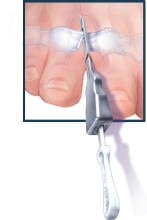|
Return to Articles Main Page
Pathology:
Morton's Neuroma is a condition first described by Dr. Thomas Morton, a Viennese physician, in 1876. The condition is quite common. It seems to occur more frequently in women than men and is usually a result of a nerve that is irritated or pinched between the bones in the ball of the foot. |

|
There are five metatarsal bones that comprise the ball of the foot. These are the long bones that extend back from the toes. Nerves course between these metatarsal bones on their way to providing sensation to the corresponding toes. If we count the big toe as number one, the most common area for Morton's Neuroma to occur is between the third and fourth toe. The reason neuromas occur more frequently in this area is because it is the only area in the front of the foot where two nerves come together. Therefore, in this particular area, (between the third and fourth metatarsal), the nerve is double the size than any other metatarsal space. As the particular nerve is irritated by the heads of the two adjacent metatarsal heads, the nerve becomes irritated and inflamed and over time it may become enlarged.
Symptoms:
Walking and/or wearing tight shoes squeezes the two metatarsals together sending a painful sensation into the two affected toes. The sensation can be sharp, electric shock like, burning, pins/needles and/or numbness. Sometimes the pain is relieved by taking off the offending shoe and massaging the ball of the foot.
Diagnosis:
The diagnosis of Morton's Neuroma is made by performing a simple test. The doctor will gently squeeze the foot from side to side and use a thumb to push up between the metatarsal heads. In advanced cases of Morton's Neuroma, there will be a snap or clicking sensation felt in the area .This is called a Mulder's Sign. The Mulder's Sign mimics what takes place in the shoe with every step. Squeezing the foot simulates the shoe and pushing up on the bottom of the foot simulates the reactive forces of the ground as it pushes against the foot with each step.
Treatment:
Approximately fifty percent of Morton's Neuromas can be effectively treated with conservative therapy. This includes better fitting shoes, pads that separate the affected metatarsal bones, prescription orthotics, and/or cortisone injections. While conservative treatment sometimes relieves the symptoms, some patients require surgical intervention. The most common surgical procedure for correcting Morton’s neuroma has been to perform a neurectomy. This consists of an incision, retraction of the metatarsal bones, and removal of the enlarged nerve. This surgery is quite successful and patients usually are up and about with minimal disability.
The New Technique:
Recently, it has been found that in many instances, releasing or cutting the affected intermetatarsal ligament allows for more space and less restriction of the nerve, especially in the third/fourth intermetatarsal space where (because of two nerves), the nerve trunk is double the size. There seems to be a shorter recovery period without the complications associated with neurectomies. This is a very safe procedure with a high success rate and it is becoming the standard care for hundreds of surgeons throughout the country.
Koby Surgical Company has developed precision instrumentation to allow doctors to effectively release the intermetatarsal ligament. The Minimally Invasive Neuroma Decompression (MIND) procedure may be performed in an outpatient surgery center. It involves placing the precision instrumentation in the affected area and releasing the intermetatarsal ligament (see Figure). |

|
The procedure takes under ten minutes and patients walk immediately afterwards. There is minimal, if any, post operative pain. Doctors in our office, have been trained to utilize this new technique and are now able to use this to aid patients return to their normal lifestyle with less pain.
Return to Articles Main Page
Our Services | Referring Physicians | About Us | Frequently Asked Questions | Blog | Articles
Surgical Animations | Links | News & Press | Photo Gallery
Contact Us | Home | Legal Notice | Privacy Statement | Site Map
Copyright © Buffalo Medical Group P.C. / Podiatry Affiliates
Website Design, Maintenance and Hosting by Catalyst Marketing / Worry Free Websites |
